GLEN CANYON, A HALF CENTURY AFTER THE DAM.. .
.
In all the years and centuries and eons before it was flooded, only a relative handful of people saw the untamed, free and flowing Colorado River in Glen Canyon. When the gates on the diversion tunnels at the massive steel and concrete dam were closed and permanently sealed in January 1963, all the history and mystery of that special place sank under 700 feet of impounded water.
Native Americans, of course, made the Glen their home for thousands of years before white men arrived in the area. I cannot imagine a more idyllic place. The remains of their culture, in ruins and rock art, was later to be found everywhere—by prospectors, ranchers, and eventually, by tourists. True to the spirit of white people, when we finally “discovered” Glen Canyon, most of us only went there in search of riches. Remoteness and solitude were qualities to be endured, not embraced. A gold boom in the 1890s created a population boom as well in southeast Utah, but only for a while. Like all booms, the fever ran its course and the place emptied out again. Some came for treasure but a few stayed for another kind of wealth.
To this ‘blank spot on the map’ came people like Cass Hite and later Art Chaffin and Woody Edgell who found home and peace in an unknown Eden, and there were wanderers like Harry Aleson and Ken Sleight and Kent Frost who were drawn here as well and who shared their love and their lives with a handful of “tourists” creative enough to seek out these kind of destinations in the first place. They were a rare breed.
Tourism in the 1950s just wasn’t living up to its potential…THANK GOD. Getting off the beaten track wasn’t fashionable back then. Spending two weeks on a remote river with no toilets or showers and not much to eat but canned fruit and beans and what fish you could pull out of the river offered little appeal to most Americans. Those who sought out places like the Glen pretty much had the run of the place. ‘The Place No One Knew’ was their place. That they knew for sure. It was like a small band of brothers and sisters who knew and held and protected a great and holy secret.
Of course, when seeking ‘the road less traveled’ finally became popular, and ‘doing’ the canyon, or ‘running the river’ became every tourism development director’s dream and marketing pitch, the sheer numbers—the hordes of thrill seekers—who descended upon that once less traveled road, now filled it to capacity and beyond. One can argue that the only thing that saved Glen Canyon from that kind of ignominious fate was the dam itself.
Oh the irony.
Today that relative handful who knew the Glen firsthand keeps shrinking. Almost 50 years have passed since the dam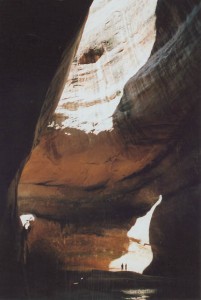 stopped the river; yet for those still alive who remember, the memories are as vivid, the pain of the loss just as acute. Listen to Ken Sleight talk about his last trip into Glen Canyon, as the reservoir behind the new dam rose inches and then feet and yards, as he watched his beloved Little Eden and Cathedral in the Desert and Dungeon Canyon and Hidden Passage and Music Temple vanish from view in a watery grave.
stopped the river; yet for those still alive who remember, the memories are as vivid, the pain of the loss just as acute. Listen to Ken Sleight talk about his last trip into Glen Canyon, as the reservoir behind the new dam rose inches and then feet and yards, as he watched his beloved Little Eden and Cathedral in the Desert and Dungeon Canyon and Hidden Passage and Music Temple vanish from view in a watery grave.
And remember Ken Sleight’s hand forming a clenched fist and his eyes glowing brightly, each time he conjures up those images. It was like that the first time I met Ken, more than 35 years ago and it will be like that again when I see him in a few weeks. This was one death he’ll never ‘get over.’ Not by a long shot. And it’s true for everyone I’ve ever met who had the privilege of being an intimate part of that place, even if it was only for a week. They never forgot.
In another 25 or 30 years, not a living soul on earth will be able to say, “I saw Glen Canyon.” The stories and the memories will have been passed along from that last lucky generation to the ones that follow. I once dreamed of a movement to decommission the damn and drain the reservoir, but recently I’ve had second thoughts. I don’t know if we’re worthy of a “restored” Glen Canyon in these conflicted, contradictory, hypocritical days of the early 21st Century.
I wondered recently if its restoration would be anything but a cash cow for the “tourist/recreation/amenities economy?” Would it simply be the latest natural wonder to be exploited by thousands of entrepreneurs and trampled by millions of insensitive, thrill-seeking recreationists? Trying to protect Glen Canyon from a shameful greed-driven economy that wraps itself in the trite banners of the ‘green’ moral high ground, all the while looking to expand its bottom line, is as noble an effort as removing the dam itself.
After decades of longing desperately to see Glen Canyon out of the water, I surprised even myself when I thought: Maybe keeping it in “liquid storage,” as Abbey once called it, is the better alternative.
Someday though, whether humans help with the effort or not, Glen Canyon will re-emerge. The reservoir will fill with sediment, the river will flow over the dam, the power of all that surging water will weaken and break the concrete aggregate, the dam will crumble and collapse, the river will flush the silt and sediment into the Gulf of California, the Glen will revive itself. In geologic time, it will happen in the blink of an eye.
It’s a certainty that gives me great comfort, even if I won’t be there to see it. In the end, what does it matter?
ABOUT THE GRAND CANYON TRUST, ‘A JUST & HEALTHY FUTURE’
& DOUG MEYER’S HONEST RESPONSE
“What this means is that corporations and those who run them cannot stop exploiting resources and amassing wealth until they have… .I cannot finish this sentence, because the truth is that can never stop; like cancer, they can only continue to expand until they kill the host.”
“To reverse the effects of civilization would destroy the dreams of a lot of people. There’s no way around it. We can talk all we want about sustainability, but there’s a sense in which it doesn’t matter that these people’s dreams are based on, embedded in, intertwined with, and formed by an inherently destructive economic and social system. Their dreams are still their dreams. What right do I — or does anyone else — have to destroy them.
At the same time, what right do they have to destroy the world?” — Derrick Jensen, Endgame: Volume 1: The Problem of Civilization
A speech titled “A Just and Healthy Future for the 100%,” and delivered by the executive director of the Grand Canyon Trust made the rounds on the internet a few weeks ago. I passed it along to a few friends and after some discussion, Doug Meyer, The Zephyr’s unpaid “Colorado Plateau Bureau Chief,” offered to write an “honest reply.”
While we all gave the speech good marks for moving his audience emotionally, we wondered if it wasn’t also somewhat detached from Reality.
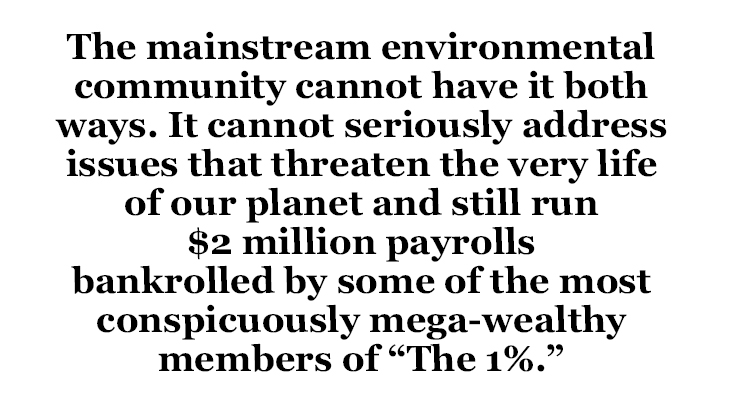
Doug Meyer is incapable of offering anything but an unvarnished opinion, unfettered by flowing rhetoric or feel-good oratory. Doug likes to stick to the facts and that is what you will find when you read his comments in this issue. If he brings tears to your eyes, it will only be because his presentation of the facts is so compelling. Sometimes people cry because they’re getting more Truth than they can handle. So…get out your hankies.
As to Bill Hedden’s speech, this paragraph particularly struck us:
“These are hard things to think about. The worst predictions you have ever heard about climate change still factored in forceful action to reduce emissions. Yet, we look away from the enormity of the threat and the changes that must be worked in our lives if we are to respond. Give us a fig leaf of deniability and we will pretend it’s just going to get a little hotter and people may have to sandbag their beach houses. And so the corporations and ideologues oblige us with their campaign denying climate change, and we gratefully keep our heads in the sand.”
It struck us because organizations like the GCT are funded in part and run by (via their boards of directors) industrialists/bankers/venture capitalists who have little or nothing to gain, and everything to lose if they really embrace and attempt to seriously reduce “the enormity of the threat,” that Hedden refers to.
The mainstream environmental community cannot have it both ways. It cannot seriously address issues that threaten the very life of our planet and still run $2 million payrolls bankrolled by some of the most conspicuously mega-wealthy members of “The 1%.”
And it cannot continue to selectively obsess itself with the environmental impacts that come from the extraction and production of natural resources and pay no attention at all to the insatiable consumption that creates the demand for production and extraction in the first place. You can’t be a GCT board member and fly to your Trust meetings in a Gulfstar jet and expect anyone to take you seriously. And it’s a stretch to take any Trust staffer seriously who knows this is the truth and continues to ignore the hypocrisy.
Most amazing, I think, is the realization that these people still think they’re doing the right thing. That they’re still the True Crusaders for the Cause. They somehow miss the contradictions. Or at least have managed to avoid them. So far.
So I urge all of you to take the time to read both Bill Hedden’s April 27 remarks and Doug’s take on them. We look forward to your comments and we offer as much space as Bill Hedden or any representative of the Grand canyon Trust would like to respond to Doug’s commentary.
You can go back to the home page or you can click here:
AN HONEST RESPONSE TO BILL HEDDEN, THE GCT &
“A Just & Healthy Future for the 100%”
THE RISE & FALL OF HAIR…A History
The other night I couldn’t sleep so I crawled out of bed and turned on the tv to see what was playing. At 2 AM, Not much—infomercials dominated the airwaves and I was sure any of these would soon return me to peaceful slumber. But one long winded commercial, for a product called Micro-touch caught my eye. Clearly it was some kind of laser-powered hair removal device, a contraption I assumed was targeted at a female audience. But a hairy arm produced itself on the screen and I let out a stifled yelp (I was trying not to awaken my wife).
Damn, I thought, that’s the hairiest woman I’ve ever seen…well, second-hairiest anyway. I was wondering where this ad might lead to next. But when the camera pulled back to reveal the rest of the tv model, I was both relieved and stricken to realize it was a man—relieved, of course, to be reassured that no woman on earth could be that hairy. And stricken because of what this male model was doing to the rest of himself.
 He took his laser-equipped Micro-touch and, in less than 30 seconds, removed every last hair from the left side of his body. He used it on his face. He removed the hairs on his head. He even used it on his ears. The announcer explained that this new product gave men the smooth and silky look they yearn for. And then he told us that with the Micro-touch, we could now remove hair from our “most sensitive areas” without fear of cuts, nicks, burns or rashes.
He took his laser-equipped Micro-touch and, in less than 30 seconds, removed every last hair from the left side of his body. He used it on his face. He removed the hairs on his head. He even used it on his ears. The announcer explained that this new product gave men the smooth and silky look they yearn for. And then he told us that with the Micro-touch, we could now remove hair from our “most sensitive areas” without fear of cuts, nicks, burns or rashes.
“Sensitive areas?”
I took a deep breath. I remembered what Thomas Jefferson said, more than two centuries ago:
“The motion of my blood can no longer keep pace with the tumult of the world.”
Once more I felt my world slipping away from me Had my planet, yet again, been turned on its formerly hairy head? I was speechless, or almost. The next day I shared my troubled late night experience with my wife but, as always, she was way ahead of me. Tonya explained the whole concept of ‘manscaping’ to me, the latest turn in men’s fashion which includes de-hairing ourselves by whatever means suits us best. My pal Ned Mudd sent me a link to the DailyBeast.com which explained in detail:
“The modern manscaped man is a product of today’s post-mextrosexual society, where even the alpha male indulges in spa treatments and $50 Diesel boxer briefs…..Manscaping has gone so mainstream that stores like Kohls and Bed, Bath & Beyond stock body trimmers right next to facial ones. “‘The Mangroomer Private Body Shaver is one of our best-selling products,’ says Mike Gilman, co-owner of the Grooming Lounge in Washington D.C., an upscale Barber Shop that serves scotch to its clients.”
spa treatments and $50 Diesel boxer briefs…..Manscaping has gone so mainstream that stores like Kohls and Bed, Bath & Beyond stock body trimmers right next to facial ones. “‘The Mangroomer Private Body Shaver is one of our best-selling products,’ says Mike Gilman, co-owner of the Grooming Lounge in Washington D.C., an upscale Barber Shop that serves scotch to its clients.”
There was a time when male hair was a thing of beauty and value. And it was a sign of maturity. A coming of age. Not to be too graphic here, but every man reading this piece will understand. As we guys approach puberty, we all keep a close watch on those special locations where manly hair begins to sprout. Nothing is more humiliating than to be in gym class, taking a group shower and be a late bloomer. I was a late bloomer. The day a small tuft of hair appeared in the regions south of my belly-button, I almost wanted to fertilize it, in hopes it would grow faster. I was ecstatic. But it was a long wait to catch up with my more rapidly maturing pals.
Same with chest hair. Even when I was in college, all those many years ago, I could only sprout a few random hairs. Nothing that added up to anything significant. My old pal Tynes claimed there was a woman who would have sex with any man who allowed her to shave his chest hair. Whether it was true or he was just torturing me and doing the cutting himself, Tynes periodically showed up to bare his hair-less chest triumphantly for anyone even slightly interested.
(EDITOR’S NOTE: Right about now my wife is saying, ‘Are you sure you want to write about this? Should I tell my mother to skip over this part?’)
More than anything, however, our head hair was a symbol…no, THE symbol of our rebellious youth. The day my hair 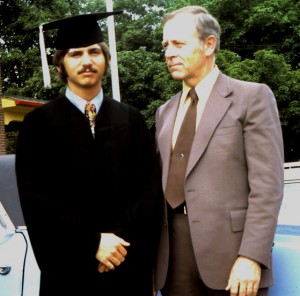 crawled over my collar and my ears was the day my father quit talking to me and I don’t think he ever got over it. A lot of men of my father’s generation were like that. When I was 20, I went out West to work the summer in Jackson, Wyoming and got a job pumping gas at Harold’s Standard, just across the street from the Wort Hotel.
crawled over my collar and my ears was the day my father quit talking to me and I don’t think he ever got over it. A lot of men of my father’s generation were like that. When I was 20, I went out West to work the summer in Jackson, Wyoming and got a job pumping gas at Harold’s Standard, just across the street from the Wort Hotel.
Harold eyed me suspiciously and finally agreed to hire me, but he said, “First though, boy, you look like a damn hippie. Go down to the barber shop and get a haircut.”
I reluctantly agreed, and to his credit, Harold gave me the money. But when I got back, he said, “I thought you was going for a haircut.”
I explained that the deed had been done but he wasn’t happy. He sent me back for another. And then another (I really needed that job). And he didn’t pay for the last two. I always figured he and the barber were in cahoots.
One night, a cowboy came by the gas station—there were a lot of cowboys back then—and even with my recent scalping, he didn’t seem to like the cut of my head.
You know?” he said, “We don’t much care for hippies around here…Did you ever hear about the big fight last year between the cowboys and the hippies? (I nodded.) Well you’re lookin’ at the man who started that fight.”
Slim explained. “I saw this damn long haired kid with greasy ol’ hair and a hat pulled down over his face. So I walked up to him, put my fist through his hat and then I put it in his face.”
He smiled contentedly. “We lined up on one side of the bar and the hippies lined up on the other..there was about six of them and twenty of us.”
Some odds. “I guess you won then?”
He sneered as he turned for the door and said, “Son…we was out to win.”
All these years later, I still hold a strong and defiant attachment for hair—mine and everybody else’s— and I hope my hair continues to hold an attachment for me. But I would never be so callous, so unfeeling, so…traitorous as to voluntarily remove the hair which I waited so long to grow and which keeps me warm in a strong wind, and which, when combed a certain way causes me to bear a slight resemblance to Rhett Butler. You may not give a damn, but I do.
Finally, in a world that seems to define itself by its incalculable scenes of violence against each other, and where we long for a friendly and non-threatening face, I would like to offer one more reason to be embrace hair. I agree that what you do to most parts of your body, hair-wise, is none of my business and I wouldn’t know and would prefer not to know if Zephyr readers are out there manscaping themselves. It’s a free country.
But when it comes to the hair that grows atop a man’s head, I beg you to quit shaving up there and turn those follicles free. Even if you’re somewhat diminished, be proud of your hair. To me, there is nothing scarier looking or more intimidating than a shaved head on a man, combined (oddly enough because in this case I’m talking more hair) with a goatee beard. Cops love this look and they should stop it. We’re scared enough when they pull us over. Why does everybody want to look so tough and mean when they could look fuzzy and kind? I once sat in a bar in Port Hedland, Australia with a bunch of iron ore miners. Everyone of them sported the scary shaved-with-a-goatee look. One of them, just for emphasis, had a human skull tattooed to the back of his head. I couldn’t tell if he was coming or going, or dead or alive.
In the end, I concede that my disdain for the bald look may simply be a different version of the bias my father once displayed against my shaggy locks. I even recall an argument with my father in which I swore I’d never scold my children for having long hair. He laughed and said, “By then they may be sporting crew-cuts again. Then what are you going to do?”
I was sure that would never happen. What young man would want to embrace such a look again? Turns out we were both wrong. But the cruel truth is, if I’m willing to admit it, I may be an anti-hair bigot. Generations of us come and go–hair grows, only to be cut off at the roots. It seems like only yesterday that the great late George Carlin embraced the subject that tore families apart. When he admonished us…
I’m aware some stare at my hair.
In fact, to be fair,
Some really despair of my hair.
But I don’t care,
’Cause they’re not aware,
Nor are they debonair.
In fact, they’re just square.
They see hair down to there,
Say, “Beware” and go off on a tear!
I say, “No fair!”
A head that’s bare is really nowhere.
So be like a bear, be fair with your hair!
Show it you care.
Wear it to there.
Or to there.
Or to there, if you dare!
If only those days could come again.
*Bonus: GEORGE CARLIN VIDEO
To read the PDF version of this article, click here.
Don’t forget the Zephyr ads! All links are hot!
And our newest Backbone members!


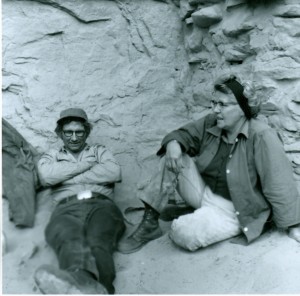
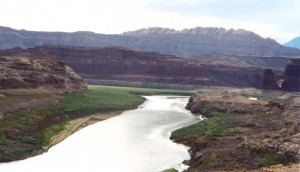
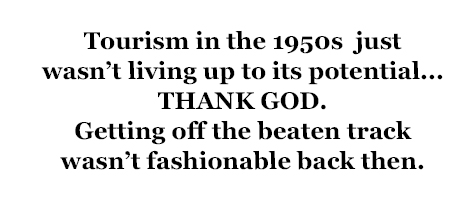
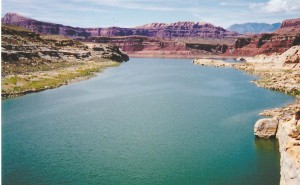

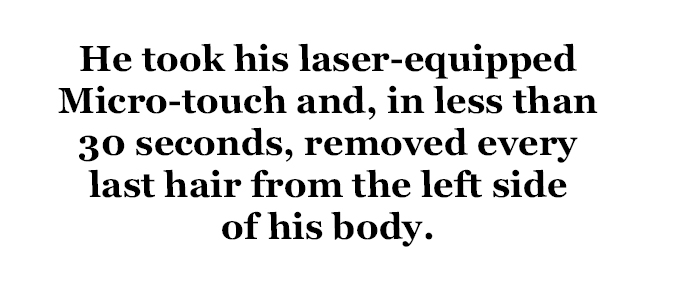
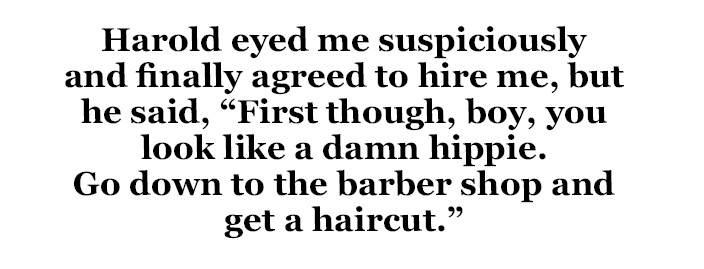
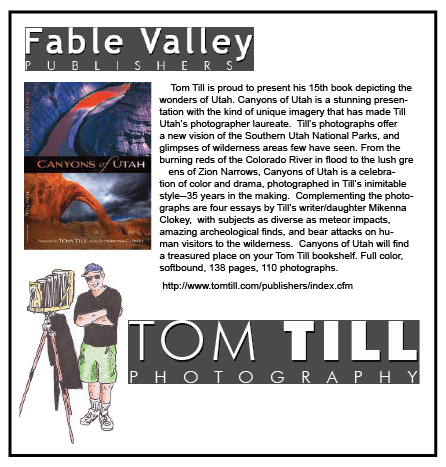
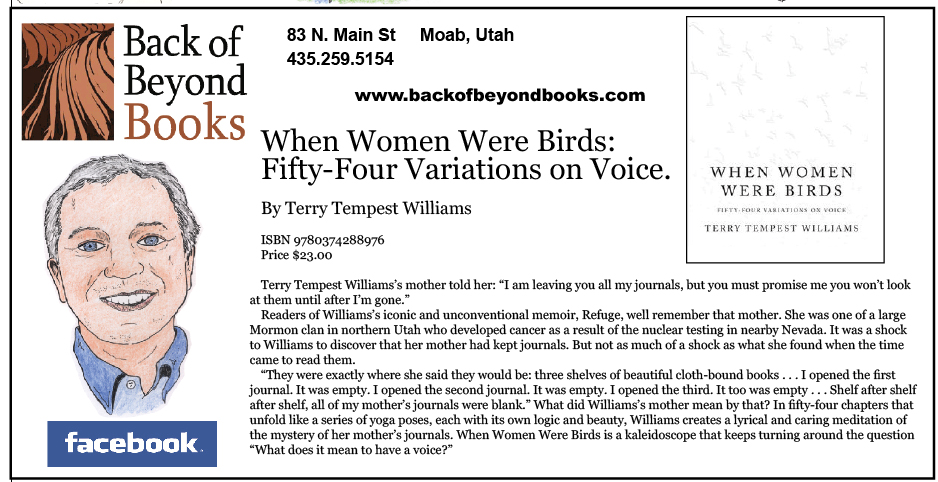
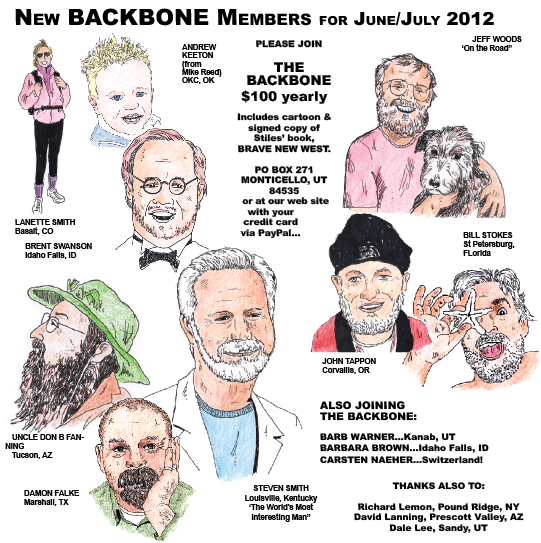
I was 14 years old, living in Mississippi, when Glen Canyon was flooded. I didn’t get out West until I was 18.
But I remember Arizona in the late 1960s, when could you drive out in practically any direction and find wildness. I felt alive out in that land in a way I’d never felt before. But by 2005, the last time I was there, that wondrous solitude of the Arizona landscape had been destroyed in every direction by development.
I will never get over that. I don’t want to get over it because that kind of destruction needs to be remembered. I simply cannot have faith in a culture that is willing to do that to a landscape.
As for manscaping, I will leave such scraping to others. I vote for body hair, freedom to fart, and a plurality of crude jokes. All sources of joy.
I am a man.
Georgie White ran raft trips in Glen Canyon in the 1950s. She gave a talk and slide show at a meeting of the Ozark Wilderness Waterways club in Kansas City in l960. I think we wrote some letters, but the dam contruction was underway then, and Georgie did not think it could be stopped. As I recall her trips were difficult, because she flew passengers into some remote spot for the put-in. You are probably right that if Glen Canyon were ressurected now it would become a crowded tourist mess.
What’s sad is that the idea of keeping Glen Canyon in liquid storage to protect it from being ravaged by the tourism economy ought to be absurd, but it’s not.